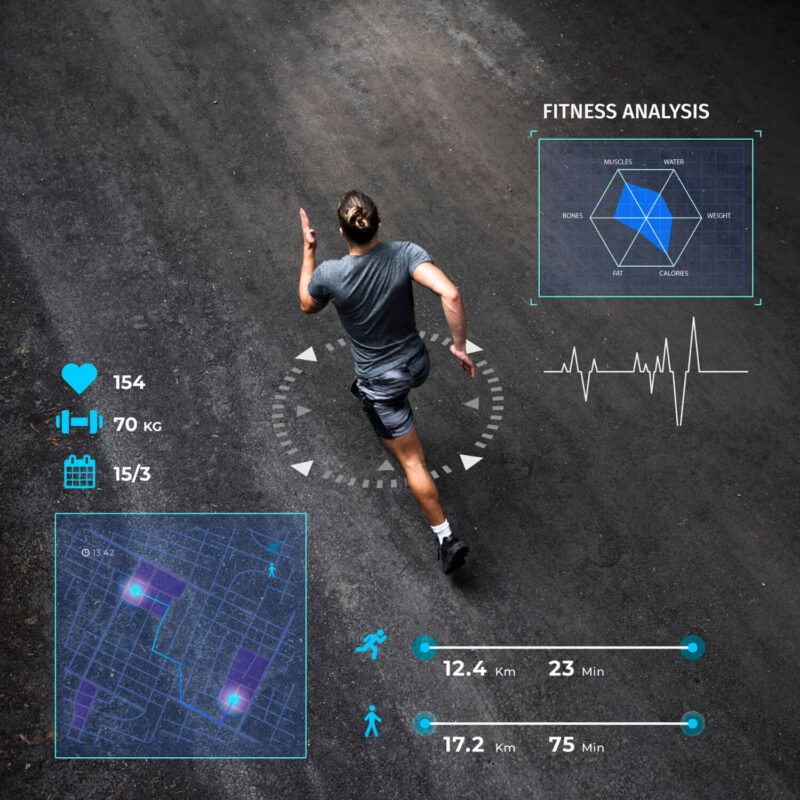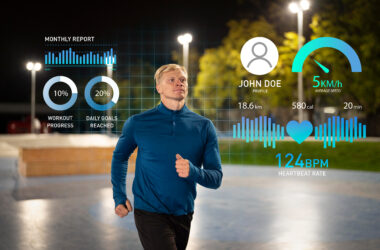The world of sports presents endless opportunities for personal growth and achievement, especially in today’s highly competitive environment. AI in sports is making its mark across various aspects, such as team management and game strategies, changing the game in ways we couldn’t have imagined before. It offers a host of advantages, from boosting performance to completely transforming how athletes train, ultimately helping you reach your athletic dreams.
Wearable technology and AI in sports training play a significant role in changing sports strategies. As data collectors, these devices gather information on athletes’ performance, heart rate, and muscle activity. This data is then processed by AI systems, providing valuable insights.
With intelligent wearables’ real-time capabilities, athletes and coaches are empowered like never before. This technology not only enhances fitness tracking and identifies areas for improvement but also enables coaches to provide immediate feedback on form and fatigue levels, giving you the confidence and control to optimize your performance. The blog will explore the world of AI-enhanced athletic training and the potential for personalized training powered by wearable tech devices.
The Evolution of Wearable Technology in Sports
The early days of wearable technology and AI in sports were marked by simple devices with limited functionality. In the 1960s, chest strap heart rate monitors were the first devices used by athletes. These early wearables laid the foundation for the more advanced devices we see today, sparking a journey of innovation and possibilities that continue to intrigue sports.
Now, smart sports wearables boast sleek designs, long battery life, and seamless integration with apps that provide in-depth data analysis. Further, the integration of wearable technology and training assists in the creation of personalized training programs tailored to each athlete’s unique needs.
It performs real-time data analysis that helps identify an athlete’s strengths, weaknesses, and potential injuries. By continuously monitoring and adapting training plans based on wearable device data insights, athletes can optimize their performance and achieve their goals faster.
Understanding Wearable Tech and AI
To understand how wearable technology and Artificial Intelligence in sports training collaborate. Imagine it as a tiny computer, typically around an athlete’s wrist whenever they train for sports like football or basketball, even if they are working out. It tracks their progress and monitors their heart rate.
These devices have sensors that collect data on the body and activities, such as activity type, distance traveled, and steps taken. After the data is gathered, complex AI algorithms are performed to analyze where the improvements are required and even suggest tweaks to your training regimen to maximize results. Seeing your progress through data can be a great motivator.
It also acts as injury prevention technology, advising athletes if their health is not on the right track and giving feedback on form or fatigue levels during exercise.
Types of Wearable Technology
The world of wearable tech in sports is vast and ever-growing. AI in sports and integrating devices further strengthen how athletes train and compete. Here is a breakdown of some key categories.
1. Smartwatches and Fitness Bands
Smartwatches are the most common wearables, offering a range of AI functions. They use AI metrics to track the progress of athletes by deeply analyzing factors like heart rate, steps, distance, and calories burned. It is easily integrated into the phone and offers built-in features like GPS for location tracking, sleep monitoring, and activity recognition (e.g., running, cycling). Moreover, it understands a person’s emotions and, therefore, assists in adjusting music to maintain the focus.
2. Smart Clothing and Sensors
This category integrates sensors directly into clothing for a remarkable user experience. As Bright shit lends help in measuring muscle activity metrics. Not only this,, but we also have smart shoes to track foot strike patterns and provide insights into running form.
3. Virtual Reality (VR) Training
VR and AR are emerging technologies with exciting potential for sports training.’ virtual training puts teams in realistic game situations, allowing them to practice under pressure without the risk of injury. And augmented devices are helpful in displaying real-time biofeedback data during training.
How AI Enhances Wearable Technology
One prominent reason for using this technology is personalized sports training programs because even working as a team can help you win a game. Every individual has their own set of weaknesses and strengths, so wearable technology and AI in sports training are the best evolution to make sure no individual gets behind. Here are some of the factors AI enhances wearable technology.
1. Data Collection and Analysis
Wearable devices collect a lot of data, but deciphering it can be overwhelming. AI excels at handling this data overload. It inspects complex sports performance analytics data for coaches and trainers to suggest trends that humans might miss.
2. Real-time Feedback and Performance Monitoring
Tracking and analyzing data to determine what team is missing out on building game-winning strategies is time-consuming. Therefore, wearable devices are there to understand the real-time data and give athletes feedback on running form or suggest a change in pace to optimize their workout. It acts like a virtual coach, analyzing your performance in real time and providing personalized recommendations to improve your technique or maximize your training session
3. Predictive Analytics for Injury Prevention
Wouldn’t it be amazing to predict potential injuries before they happen? Many sports industries experience decreased revenue due to last-minute failures in any sports activity. However, AI in sports addresses these challenges and suggests adjustments to the training programs for each individual according to their body strength. Knowing you’re taking steps to avoid injuries allows them to train more confidently.
Personalizing Training with Wearable Tech and AI
It is a universal fact that the sports industry often neglects that every individual has specific weaknesses that need a personalized approach rather than team practice. AI in sports shows how teams can give their best if they have tailored exercises to address them directly, leading to faster improvement. Let’s delve into how this dynamic duo personalizes training for peak performance:
1. Tailored Training Programs
The old practices, which are one-size-fits-all, are gone. It’s 2024, and we need the best approach to creating a customized training program. Therefore, wearable technology and AI in sports refine traditional in-depth training plans. Whether aiming for a marathon or improving your fitness, AI tailors your program to achieve your objectives.
2. Customizing Workouts and Recovery
These devices listen to the athlete’s body and requirements. They collect real-time data on factors like heart rate and sleep patterns. AI analyzes this data and recommends adjustments to workout intensity or recovery routine based on the athlete’s needs. It even acts as your personal fitness coach, creating dynamic workout plans that adapt to your performance. For example, if you’re exceeding expectations, AI suggests pushing yourself further, or vice versa.
3. Achieving Peak Performance
To perform well in any sports activity, it gives real-time feedback on your running form or stroke technique during a workout. AI uses data from wearables to provide this valuable feedback, helping you refine your technique and become more efficient.
Challenges and Considerations in Wearable Tech
Despite the exciting possibilities, wearable technology and AI in sports also have challenges that must be addressed.
1. Data Privacy and Security
Wearable devices have sensors that collect real-time data on athletes. Only the track metrics, not anything peripheral, must be used to improve athletes’ sports performance. Continuous regulation and monitoring are needed so that no trainer in the sports industry can gain the advantage of athlete information.
2. Accuracy and Reliability of Devices
Wearables rely on sensors, and the accuracy of the data they collect can be affected by factors such as their placement on the body or environmental conditions. Athletes and coaches must be aware of these limitations and rely on the data with other training methods.
3. Ensuring Inclusivity and Accessibility in Sports Technology
Wearable technology can be expensive, potentially excluding athletes from lower-income backgrounds. Efforts must be made to develop more affordable wearables and ensure all athletes can access this technology.
The Future of Wearable Tech and AI in Sports Training
In the above, we have seen numerous benefits wearable technology and AI in sports training have provided. The sports industry is ever-changing, and so are AI technologies. We might see more exciting possibilities and future technologies that will shape the landscape of sports training for professional and amateur athletes.
We’ll move beyond wristbands and watches. Clothing itself will become a data collection platform. Bright shirts embedded with sensors will track a broader range of biometrics, offering a deeper understanding of an athlete’s performance. This real-time data will allow for more precise adjustments to training programs and improved injury prevention strategies.
AI is poised for a significant leap forward. Machine learning algorithms will become even more sophisticated and able to analyze an athlete’s internal data and external factors like weather and nutrition. This holistic approach will provide a 360-degree view of an athlete’s performance, allowing for highly personalized training strategies with a maximized impact on results.
One of the most prominent future changes athletes desire in the sports industry is to afford wearable devices. This democratization of wearable tech will ensure that personalized training is no longer a privilege reserved for professional athletes but a standard for everyone who wants to optimize their performance and reach their full potential.
Conclusion:
In conclusion, the future of wearable technology and AI Services in sports training is brimming with possibilities. From bright clothing with embedded sensors to advanced AI analysis and VR simulations, these technologies hold the potential to reshape the way athletes train and compete. The ultimate goal is to create a world where personalized training is accessible, empowering athletes of every level to achieve peak performance while maintaining fairness and ethical practices.
Frequently Asked Questions (FAQs)
How Does AI-Enhanced Wearable Technology Personalize Training for Athletes?
It acts as a personal trainer that looks at every activity of an athlete, whether it’s about fitness or suggesting workouts. AI-powered wearables personalize training for athletes by analyzing their data.
What Are the Benefits of Using Wearable Technology in Sports Training?
One of the visible benefits of using these devices is that they offer real-time feedback and data-driven training, helping athletes train smarter and achieve their goals.
How Can Wearable Tech and AI Help in Preventing Sports Injuries?
It tracks athletes’ heart rates, making it easy to identify potential injury risks. But that’s not all wearable technology can do. It also gathers data on an athlete’s movements and form, which can help coaches and trainers spot any irregularities or imbalances that could lead to injuries.
What Types of Wearable Technology Are Most Commonly Used in Sports Today?
Today’s most common sports wearables are smartwatches and fitness trackers that track basics like heart rate, steps, distance, and calories burned.
What Challenges Do Athletes and Coaches Face When Integrating AI and Wearable Technology Into Training Programs?
Athletes and coaches integrating AI and wearables face a few challenges in ensuring the security of personal data collected by wearables. Furthermore, we can’t rely on wearable data accuracy and trust AI recommendations while still using experience and judgment.

Dawood is a digital marketing pro and AI/ML enthusiast. His blogs on Folio3 AI are a blend of marketing and tech brilliance. Dawood’s knack for making AI engaging for users sets his content apart, offering a unique and insightful take on the dynamic intersection of marketing and cutting-edge technology.










